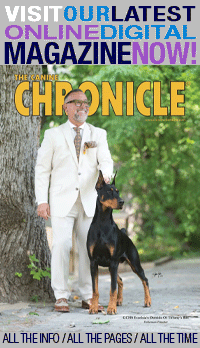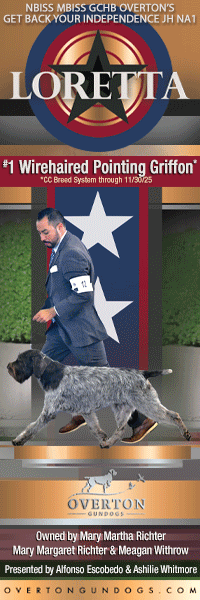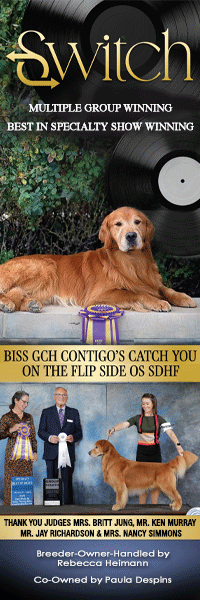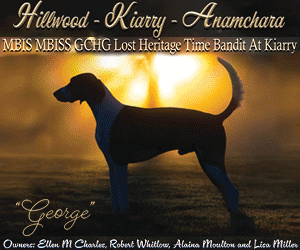New Dog Breeds Recognized By The FCI – Cimarron Uruguayo
300 – August, 2013 (click to see full digital story)
text and illustrations by Ria Hörter
Courtesy Dr. Francisco Gonzalez, Uruguay

The head shows several molossian characteristics: a powerful muzzle slightly shorter than the skull; broad nose; and powerful jaws.
The FCI (Fédération Cynologique Internationale), the World Canine Organization, includes 86 member countries and contract partners (one member per country). Each issues its own pedigrees and trains its own judges. The FCI ensures that the pedigrees and judges are mutually recognized by all FCI members.
Recognition of a breed by the FCI means that in almost every European country, that breed can be awarded FCI championship prizes. The Cimarrón Uruguayo (Uruguayan Cimarron) was provisionally accepted by the FCI in February 2006.
PAMPAS
The Oriental Republic of Uruguay, a country of approximately 175,000 square kilometers, is situated in the southeastern part of South America. Uruguay has about 3.5 million inhabitants of whom 1.8 million live in the capital, Montevideo. An estimated 88 percent of the population is of European origin.
A large part of the country is covered with grass – the pampas, a large flat plain with some small bushes and few trees, that is suitable for livestock breeding. Uruguay had its own cowboys, the gauchos, nomadic horsemen who lived on the pampas while hunting wild cattle.
Most Uruguayans are descended from Spanish – especially Basque – and Italian conquerors and settlers. Before European colonization, the only documented inhabitants were the Charrúa people, a small nomadic tribe living along the Rio de la Plata as hunters and fishermen.
CATTLE
The Spanish discovered the territory of present-day Uruguay in 1516, but native resistance to conquest limited settlement in the region during the 16th and 17th centuries.
Because the area lacked gold and silver, the Spanish began to introduce cattle in 1603, to become a source of wealth in the region. And, where there is cattle, dogs are needed. During the 17th century, horses, cattle and dogs were imported to Uruguay from Europe.
CIVIL WAR AND A MILITARY COUP
In 1811, José Gervasio Artigas launched a successful revolt against Spain, defeating Spanish forces on May 18 at the Battle of Las Piedras. In 1814, he formed the Liga Federal (Federal League) of which he was declared Protector. We will meet Artigas – Uruguay’s national hero – later, in the history of the Cimarrón Uruguayo.
Other names of the Cimarrón Uruguayo
- Cimarron Creole
- Cimarron Dog
- Maroon Dog
- Cerro Largo Dog
- Uruguayan Gaucho Dog
- Perro Cimarron
CIMARRON = WILD OR FERAL
“Cimarrón” is a Spanish word used in many applications; for example, it’s the name of a mountain chain in Colorado, villages in New Mexico and Kansas, and a brand of French jeans. The English translation of Cimarrón – “wild, untamed or undomesticated” – is a clue to the breed’s early history: Cimarrón Uruguayo means “untamed in Uruguay.” In Uruguay, the word cimarrón is used for anything wild as opposed to domestic.
SPANISH AND PORTUGUESE CONQUERORS

“Las Meninas” – The family of King Felipe IV of Spain. Painting (1656) by Velasquez, Museo del Prado, Madrid. This type of mastiff is one of the forerunners of the Cimarrón Uruguayo.
About the history of the Uruguayan Cimarrón, the FCI standard states: “The origin of the CIMARRÓN Uruguayo is uncertain. It is known to be descended from the dogs introduced by the Spanish and Portuguese conquerors.
“These dogs left in the country crossed among themselves. Natural selection had as a result that only the fitter, the stronger and more clever individuals survived. This is how the Cimarrón was born.
“The inhabitants of the time, recognizing the value of these dogs, domesticated them and progressively began to use them successfully as guards of their estates and as herding dogs in their daily work with cattle.”
The FCI uses the word “uncertain” in describing the breed’s early history. “Uncertain” also applies to the origin of many other types of dogs taken from Europe to the colonies in South America from the 15th to 18th century. They were cross-bred and their history was seldom documented. However, we know what these types of dogs looked like, thanks to paintings and other old depictions.
It is assumed that the “old Spanish presa” and other Spanish and Italian molossian types were the forerunners of the Cimarrón Uruguayo. Some writers assert that the molossian types were crossbred (in Uruguay?) with sighthounds to achieve more speed and versatility, but I did not find any evidence to support this claim.
In South America and elsewhere, European dogs were developed into new breeds that showed a remarkable similarity. Think, for example, of the Dogo Argentino in Argentina, the Dogo Canario on the Canary Islands, the Cão Fila de São Miguel on the Azores, and the Fila Brasileiro in Brazil. Each has old molossian and/or old mastiff blood in its veins. Sometimes the similarity is striking, even after more than five centuries and separated by thousands of miles.
SEMI-WILD
In Uruguay, many of the domesticated animals, including the dogs, brought by Europeans during colonization, were set free and became more or less feral. Although there is no written history, we can be certain that the Cimarrón Uruguayo comes from crossings among the dogs brought in by Spanish, Portuguese and Italian conquerors and colonists. Only the strongest survived and, thanks to natural selection, developed into a strong and intelligent dog.
Unfortunately, their numbers became too large to be sustained and they began attacking livestock and even humans. As a result, thousands of dogs were killed at the end of the 18th and beginning of the 19th century when the government paid a bounty for each dog killed; a jaw or an ear was provided as evidence.
It is said that large numbers of bitches and their puppies escaped to the woods along the Olimar River, to the Sierra de Otazo and the Cerro Largo (hence the name Cerro Largo Dog), a region bordering Brazil. Recognizing them as good cattle drivers and guard dogs, local rangers started to breed these dogs, keeping the puppies that showed the same qualities as their parents. Gauchos used the dogs with their cattle, but they also proved to be useful for hunting big game and as guard dogs. Thanks to these rangers and gauchos, Uruguay now boasts a national breed with a number of working qualities.
NATIONAL RECOGNITION
In 1969, the Cimarrón was entered at a Uruguayan Kennel Club dog show for the first time. Twenty years later, in 1989, the breed got its national recognition by the Asociación Rural del Uruguay and by the Kennel Club Uruguayo (KCU, founded in 1938).
A breeders club – la Asociación de Criadores de Cimarrones Uruguayos – was founded and wrote the first breed standard in cooperation with the KCU, which maintains the studbook. The number of registered Cimarróns in Uruguay is now about 2,000. Outside Uruguay, the breed is present in Brazil, Argentina, the United States, and in some European countries, such as Sweden and the Czech Republic.
In the 1980s, the breed became popular in cities, especially in Montevideo. Breeders and the University of Montevideo signed an agreement and genetic studies have been undertaken by the College of Veterinary Medicine. Information about the genetic studies can be found on the Internet. Cimarrón breeders are now united in the Sociedad de Criadores de Cimmarón Uruguayo – website: www.sccu.com.uy
JOSE ARTIGAS
Cimarrón fanciers like to quote the Uruguayan national hero and freedom fighter José Gervasio Artigas (1764-1850), who fought for independence from Spain. At a time of need, when many soldiers were losing their lives, Artigas wrote to General Carlos Federico Lecor, “When I run out of soldiers, I will fight with the Cimarrón dogs.” This phrase has come to stand for independence and loyalty.
The Cimarrón is now a national symbol in Uruguay, was honored with a stamp issued in 1995, and is currently the mascot of the National Army of Uruguay, taking pride of place in the annual Constitution Day parade on July 18. On this occasion, a soldier of the Artigas Blandengues Regiment (honor guard and escort to the president) is accompanied by a Cimarrón Uruguayo.
The connection between José Artigas and the Cinmarrón goes further: in 2007, the fourth Cimarrón dog show was held in the old headquarters building of the Blandengues Corps once led by (then-Captain) Artigas.
BREED STANDARD
As far as I know, there is no special book about the Cimarrón, but a prominent writer and composer in Uruguay, Pedro Martins Marins (“Duca”) – wrote a booklet about the breed: Los Cimarrones en el Uruguay – Monografia del Perro. It contains only 12 pages and is on offer on the Internet for $200!
Apart from being a cattle driver and guard dog, the Cimarrón is a hunting dog on big game – especially wild boar – and companion dog.
The breed’s FCI standard states that the Cimarrón Uruguayo is a “medium-sized dog of molossian type; strong, compact, with good bones; well muscled and agile.” Its temperament is “balanced, intelligent and of great courage.”

The height at the withers is the same as the height at the croup. The topline is level or slightly saddle-backed, loins are slightly arched. A typical male from Uruguay. Photographer unknown
There are some important proportions: the height at the withers is equal to the height at the croup; and the height to the elbow is the same as from elbow to withers. The muzzle is only slightly shorter than the skull, measured from occiput to stop. The skull is wider than long, the stop is moderate.
The head shows several molossian characteristics: a powerful muzzle slightly shorter than the skull; a broad nose; and strong, powerful jaws with complete scissor bite. The medium, almond-shaped eyes have an inquisitive expression, the color any shade of brown and in accordance with the coat color.
The medium-sized, triangular drop ears are not held close to the cheeks. They may be cropped round in shape, looking like puma ears, but not more than half their length. The neck is strong, not too long, and well-muscled.
The topline is level or slightly saddle-backed; the loins are slightly arched. The chest is broad, deep, well-developed, reaching at least to the elbow. The ribs are well-sprung and the forechest well-defined. The Cimarrón’s tail is thick and medium-set, reaching to the hock, and carried horizontally or slightly upward in motion.
MOVEMENT, COAT AND SIZE
The forequarters and hindquarters are straight and parallel, the shoulderblade well laid back. Elbows turn neither in nor out. Forearms are strong-boned, the hindquarters well-muscled and powerful. The stifles are well-angulated; the oval front feet and hind cat feet have strong pads. Movement is effortless, with good reach and drive, single tracking with increased speed.
The thick, supple skin is covered with short, smooth hair growing close to the body. There is an undercoat. Coat color is brindle or all shades of fawn, with or without a mask. Fawns may have black shadings. White marks are allowed on the underjaw, lower part of the neck, forechest, abdomen and lower part of the legs.
The Cimarrón weighs between 35 and 40 kilograms (77 to 88 pounds). The height at the withers is 58 to 61 centimeters (23 to 24 inches) for dogs (two-centimeters [3/4-inch] tolerance), and 55 to 58 centimeters (22 to 23 inches) for bitches (two-centimeters [3/4-inch] tolerance).
Lips excessively pendulous at the corners; excessive dewlap; too-prominent cheeks; and two missing first premolars are regarded as faults. White markings with the exception of those mentioned above; clear departure from the important proportions; absence of sexual dimorphism; and size under or over the stipulated height (including the tolerance) are severe faults. Eliminating faults are aggression or over-shyness; long hair; any color not mentioned; undershot or overshot jaw; and clear lack of type.
The Cimarrón Uruguayo has no breed club in the United States.
Attempts were made to find the names of the photographers. Unfortunately we did not succeed in all cases. If you think you have copyrights on photos, please contact the author.
Short URL: http://caninechronicle.com/?p=31353
Comments are closed













